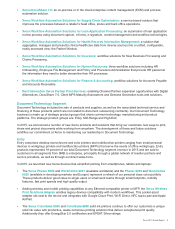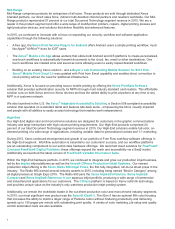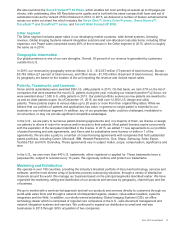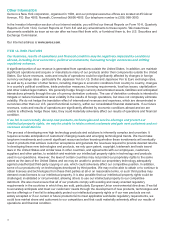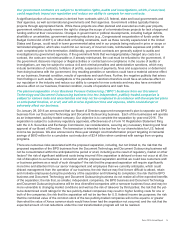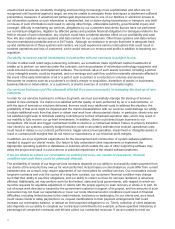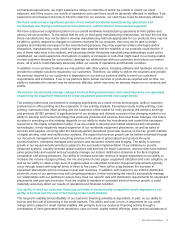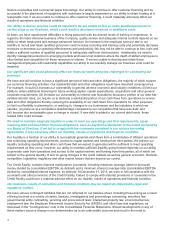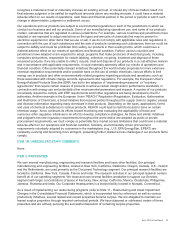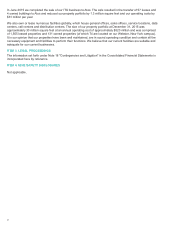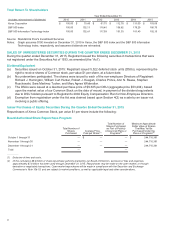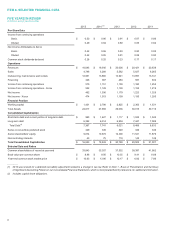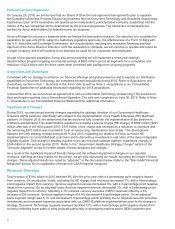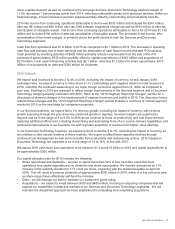Xerox 2015 Annual Report Download - page 35
Download and view the complete annual report
Please find page 35 of the 2015 Xerox annual report below. You can navigate through the pages in the report by either clicking on the pages listed below, or by using the keyword search tool below to find specific information within the annual report.contractual requirements, we might experience delays in collection of and/or be unable to collect our client
balances, and if this occurs, our results of operations and cash flows could be adversely affected. In addition, if we
experience an increase in the time to bill and collect for our services, our cash flows could be adversely affected.
We have outsourced a significant portion of our overall worldwide manufacturing operations and
increasingly are relying on third-party manufacturers, subcontractors and external suppliers.
We have outsourced a significant portion of our overall worldwide manufacturing operations to third parties and
various service providers. To the extent that we rely on third-party manufacturing relationships, we face the risk that
those manufacturers may not be able to develop manufacturing methods appropriate for our products, they may not
be able to quickly respond to changes in customer demand for our products, they may not be able to obtain
supplies and materials necessary for the manufacturing process, they may experience labor shortages and/or
disruptions, manufacturing costs could be higher than planned and the reliability of our products could decline. If
any of these risks were to be realized, and assuming similar third-party manufacturing relationships could not be
established, we could experience interruptions in supply or increases in costs that might result in our being unable
to meet customer demand for our products, damage our relationships with our customers and reduce our market
share, all of which could materially adversely affect our results of operations and financial condition.
In addition, in our services business we may partner with other parties, including software and hardware vendors, to
provide the complex solutions required by our customers. Therefore, our ability to deliver the solutions and provide
the services required by our customers is dependent on our and our partners' ability to meet our customers'
requirements and schedules. If we or our partners fail to deliver services or products as required and on time, our
ability to complete the contract may be adversely affected, which may have an adverse impact on our revenue and
profits.
We need to successfully manage changes in the printing environment and market because our operating
results may be negatively impacted by lower equipment placements and usage trends.
The printing market and environment is changing significantly as a result of new technologies, shifts in customer
preferences in office printing and the expansion of new printing markets. Examples include mobile printing, color
printing, continuous feed inkjet printing and the expansion of the market for entry products (A4 printers) and high-
end products (B1/B2 printers). A significant part of our strategy and ultimate success in this changing market is our
ability to develop and market technology that produces products and services that meet these changes. Our future
success in executing on this strategy depends on our ability to make the investments and commit the necessary
resources in this highly competitive market. If we are unable to develop and market advanced and competitive
technologies, it may negatively impact expansion of our worldwide equipment placements, as well as sales of
services and supplies occurring after the initial equipment placement (post sale revenue) in the key growth markets
of digital printing, color and multifunction systems. We expect that revenue growth can be further enhanced through
our document management and consulting services in the areas of personalized and product life cycle
communications, enterprise managed print services and document content and imaging. The ability to achieve
growth in our equipment placements is subject to the successful implementation of our initiatives to provide
advanced systems, industry-oriented global solutions and services for major customers, improve direct and indirect
sales productivity and expand and successfully manage our indirect distribution channels in the face of global
competition and pricing pressures. Our ability to increase post sale revenue is largely dependent on our ability to
increase the volume of pages printed, the mix and price of color pages, equipment utilization and color adoption, as
well as our ability to retain a high level of supplies sales in unbundled contracts. Equipment placements typically
occur through leases with original terms of three to five years. There will be a lag between the increase in
equipment placements and an increase in post sale revenues. In addition, with respect to our indirect distribution
channels, many of our partners may sell competing products, further increasing the need to successfully manage
our relationships with our partners to ensure they meet our specific sale and distribution requirements for equipment
placements and post sale revenues. If we are unable to maintain a consistent trend of revenue growth, it could
materially adversely affect our results of operations and financial condition.
Our ability to fund our customer financing activities at economically competitive levels depends on our
ability to borrow and the cost of borrowing in the credit markets.
The long-term viability and profitability of our customer financing activities is dependent, in part, on our ability to
borrow and the cost of borrowing in the credit markets. This ability and cost, in turn, is dependent on our credit
ratings and is subject to credit market volatility. We primarily fund our customer financing activity through a
combination of cash generated from operations, cash on hand, capital market offerings, sales and securitizations of
Xerox 2015 Annual Report 18


